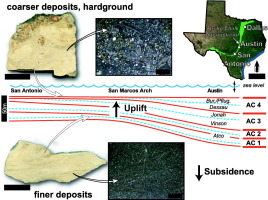当前位置:
X-MOL 学术
›
Sediment. Geol.
›
论文详情
Our official English website, www.x-mol.net, welcomes your feedback! (Note: you will need to create a separate account there.)
Tectonic and eustatic impact on depositional features in the upper cretaceous Austin Chalk Group of south-Central Texas, USA
Sedimentary Geology ( IF 2.8 ) Pub Date : 2020-05-01 , DOI: 10.1016/j.sedgeo.2020.105632 John R. Cooper , Alexis Godet , Michael C. Pope
Sedimentary Geology ( IF 2.8 ) Pub Date : 2020-05-01 , DOI: 10.1016/j.sedgeo.2020.105632 John R. Cooper , Alexis Godet , Michael C. Pope

|
Abstract The upper Cretaceous Austin Chalk Group in south-central Texas, USA, displays vertical and lateral variations in thickness and facies resulting from an irregular paleotopography of the seafloor and variable preservation of 3rd-order sea-level cycles. During the Coniacian to early Campanian, the tectonic evolution of the San Marcos Arch, a prominent basement feature in the study area, impacted facies and sequence architecture within the Austin Chalk Group. Outcropping sections of the Austin Chalk Group along the margin of the Edwards Plateau in south-central Texas stratigraphically transition between inner and outer ramp environments. The cyclic stacking pattern of facies is recorded in vertical stratigraphic succession as 3rd-order cycles separated by discontinuity surfaces and condensed deposits. Inner ramp facies consist of Thalassinoides-burrowed bivalve wackestone to packstone with minor occurrences of skeletal grainstone. Outer ramp facies comprise Planolites-burrowed foraminiferal chalk and marl with fine skeletal debris. Condensed facies associated with transgressive re-working are characterized by glauconitic packstone with high concentrations of coarse skeletal debris and lithoclasts. Gamma-ray profiles of outcrops investigated in the study area are correlated to subsurface wireline logs of wells drilled along the outcrop and subsurface trend, in order to construct a stratigraphic framework across the San Marcos Arch. This stratigraphic framework is biostratigraphically well constrained and correlated to the type section of the Austin Chalk Group farther north in the vicinity of Austin. The integration of sedimentological and stratigraphic information enables the identification of four regional 3rd-order depositional sequences within the Austin Chalk Group. Thickness maps of each depositional sequence illustrate the tectonic evolution of the San Marcos Arch and its influence on the deposition of the Austin Chalk Group, which is judged as negligible during most of the lower Austin Chalk Group (Coniacian), and started to trigger lateral thickness variations and pinch-outs in the Santonian and early Campanian. Syndepositional tectonic movement played an active role in the geometry of Austin Chalk depositional sequences and should be accounted for in sequence stratigraphic models developed in chalk depositional settings to explain the occurrence of coarser and cleaner facies.
中文翻译:

美国德克萨斯州中南部上白垩统奥斯汀白垩群沉积特征的构造和浮沉影响
摘要 美国德克萨斯州中南部的上白垩纪奥斯汀白垩群显示出由于海底古地形不规则和三级海平面旋回的可变保存导致的厚度和相的垂直和横向变化。在 Coniacian 到早期 Campanian 期间,研究区突出的基底特征 San Marcos Arch 的构造演化影响了 Austin Chalk Group 内的相和层序结构。德克萨斯州中南部沿爱德华兹高原边缘的 Austin Chalk Group 的露头部分在内部和外部斜坡环境之间进行地层过渡。相的循环堆积模式在垂直地层序列中被记录为由不连续面和凝聚沉积物分隔的三级旋回。内斜坡相由 Thalassinoides 挖洞的双壳类瓦砾岩组成,具有少量的骨架颗粒岩。外斜坡相包括 Planolites 钻孔的有孔虫白垩和泥灰岩,带有细小的骨骼碎片。与海侵再加工相关的凝聚相的特征是具有高浓度的粗骨碎屑和碎屑岩的海青质灰岩。在研究区调查的露头的伽马射线剖面与沿露头和地下趋势钻探的井的地下电缆测井相关联,以构建跨越圣马科斯拱门的地层框架。这个地层框架在生物地层学上受到很好的约束,并且与奥斯汀附近更北部的奥斯汀白垩群的类型剖面相关。沉积学和地层信息的整合使得能够识别 Austin Chalk Group 内的四个区域三级沉积序列。每个沉积序列的厚度图说明了圣马科斯拱门的构造演化及其对奥斯汀白垩群沉积的影响,在下奥斯汀白垩群(Coniacian)的大部分时间被判断为可以忽略不计,并开始触发横向厚度桑托阶和坎帕阶早期的变异和尖峰。同沉积构造运动在奥斯汀白垩沉积层序的几何形状中发挥了积极作用,应该在白垩沉积环境中开发的层序地层模型中加以考虑,以解释更粗和更清洁相的出现。
更新日期:2020-05-01
中文翻译:

美国德克萨斯州中南部上白垩统奥斯汀白垩群沉积特征的构造和浮沉影响
摘要 美国德克萨斯州中南部的上白垩纪奥斯汀白垩群显示出由于海底古地形不规则和三级海平面旋回的可变保存导致的厚度和相的垂直和横向变化。在 Coniacian 到早期 Campanian 期间,研究区突出的基底特征 San Marcos Arch 的构造演化影响了 Austin Chalk Group 内的相和层序结构。德克萨斯州中南部沿爱德华兹高原边缘的 Austin Chalk Group 的露头部分在内部和外部斜坡环境之间进行地层过渡。相的循环堆积模式在垂直地层序列中被记录为由不连续面和凝聚沉积物分隔的三级旋回。内斜坡相由 Thalassinoides 挖洞的双壳类瓦砾岩组成,具有少量的骨架颗粒岩。外斜坡相包括 Planolites 钻孔的有孔虫白垩和泥灰岩,带有细小的骨骼碎片。与海侵再加工相关的凝聚相的特征是具有高浓度的粗骨碎屑和碎屑岩的海青质灰岩。在研究区调查的露头的伽马射线剖面与沿露头和地下趋势钻探的井的地下电缆测井相关联,以构建跨越圣马科斯拱门的地层框架。这个地层框架在生物地层学上受到很好的约束,并且与奥斯汀附近更北部的奥斯汀白垩群的类型剖面相关。沉积学和地层信息的整合使得能够识别 Austin Chalk Group 内的四个区域三级沉积序列。每个沉积序列的厚度图说明了圣马科斯拱门的构造演化及其对奥斯汀白垩群沉积的影响,在下奥斯汀白垩群(Coniacian)的大部分时间被判断为可以忽略不计,并开始触发横向厚度桑托阶和坎帕阶早期的变异和尖峰。同沉积构造运动在奥斯汀白垩沉积层序的几何形状中发挥了积极作用,应该在白垩沉积环境中开发的层序地层模型中加以考虑,以解释更粗和更清洁相的出现。


























 京公网安备 11010802027423号
京公网安备 11010802027423号